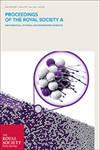Modification of Turing patterns through the use of time-varying anisotropic diffusion
IF 3
3区 综合性期刊
Q1 MULTIDISCIPLINARY SCIENCES
Proceedings of the Royal Society A: Mathematical, Physical and Engineering Sciences
Pub Date : 2023-10-01
DOI:10.1098/rspa.2023.0487
引用次数: 0
Abstract
The Turing mechanism underpinning pattern formation in reaction–diffusion relies on the interplay between diffusion parameters and reaction kinetics. Diffusion is typically assumed isotropic, however anisotropic diffusion is known to arise in both nature and laboratory conditions. We study how the Turing instability and resulting Turing patterns are modified when the underlying diffusion tensor is both anisotropic and time-dependent, modelling, for instance, chemical species reacting and diffusing through time-varying anisotropic media. We show that the set of unstable wavenumber vectors corresponding to Turing modes evolve in a spatially biased manner under this anisotropy, thereby modifying the spatial scale and structure of any resulting Turing patterns differently along each spatial coordinate. We employ this spatial bias to develop control strategies to modify the shape or even structure of Turing patterns over time. We are able to make minor changes to the aspect ratio of Turing patterns, such as morphing circular Schnakenberg spots into elliptical spots, as well as more major changes to the structure of patterns, for instance converting Gierer–Meinhardt spots into stripes or FitzHugh–Nagumo labyrinthine patterns into target patterns. Our results suggest that time-varying anisotropic media may be used as a tool by which to modify and even control Turing patterns.通过使用时变各向异性扩散修正图灵模式
图灵机制是反应扩散过程中图案形成的基础,它依赖于扩散参数和反应动力学之间的相互作用。扩散通常被假定为各向同性,然而,已知在自然界和实验室条件下都会出现各向异性扩散。我们研究了当底层扩散张量同时具有各向异性和时间依赖性时,图灵不稳定性和由此产生的图灵模式是如何被修改的,例如,模拟化学物质在时变各向异性介质中的反应和扩散。我们发现图灵模式对应的一组不稳定波数向量在这种各向异性下以空间偏置的方式演化,从而沿着每个空间坐标改变任何产生的图灵模式的空间尺度和结构。我们利用这种空间偏差来开发控制策略,以随着时间的推移修改图灵图案的形状甚至结构。我们能够对图灵图案的纵横比进行微小的改变,例如将圆形Schnakenberg斑点变成椭圆形斑点,以及对图案结构进行更大的改变,例如将Gierer-Meinhardt斑点变成条纹或将FitzHugh-Nagumo迷宫图案变成目标图案。我们的研究结果表明,时变各向异性介质可以作为一种工具来修改甚至控制图灵模式。
本文章由计算机程序翻译,如有差异,请以英文原文为准。
求助全文
约1分钟内获得全文
求助全文
来源期刊
CiteScore
6.40
自引率
5.70%
发文量
227
审稿时长
3.0 months
期刊介绍:
Proceedings A has an illustrious history of publishing pioneering and influential research articles across the entire range of the physical and mathematical sciences. These have included Maxwell"s electromagnetic theory, the Braggs" first account of X-ray crystallography, Dirac"s relativistic theory of the electron, and Watson and Crick"s detailed description of the structure of DNA.

 求助内容:
求助内容: 应助结果提醒方式:
应助结果提醒方式:


